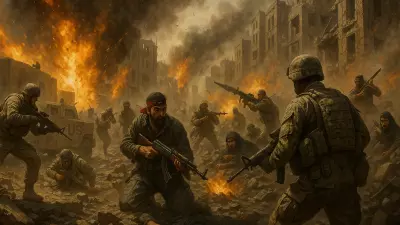Were the United States to send ground forces into Iran, most of whom would hail from Postindustrial America, the outcome would be so cataclysmic that it’d make the Iraq War look like a well-conceived, resounding success.

Right off the top: I’m not calling into question the ability or conviction of American service members, far from it.
Anyone who knows me and my background as a reporter in Afghanistan and Iraq recognizes I have great respect for them.
Not only did they risk their lives so the vast majority of Americans back home could safely armchair quarterback those conflicts, but it was soldiers who saved me after I was seriously injured in a Taliban attack.
If anything, I’m biased in their favor.
The reasons why I suggest we’d get clobbered in an Iranian ground war are mainly due to the ineptitude and hubris of the civilian leaders commanding American forces.
Egomaniacal and ignorant Trump, coupled with perpetually soused Secretary of Defense Pete Hegseth, aspiring POTUS Vice President JD Vance, and Secretary of Defense Marco Rubio, along with others, are not up to the task of carrying out a complex ground war in Iran.
They have neither the experience nor the inclination to seek the advice of those with the requisite expertise to coordinate the movement of hundreds of thousands of troops (maybe even a million) and trillions of dollars in logistical support required to conduct a war in a large, hostile, environmentally brutal country like Iran.
America couldn’t do it effectively in Iraq, a much smaller country with far fewer enemy combatants, with neocon war hawks like then-Vice President Dick Cheney and Secretary of Defense Donald Rumsfeld at the helm.
This current cadre of national defense lightweights would lead troops into inevitable slaughter.
Here are some of the reasons why invading Iran with ground forces, most of which would be comprised of sons and daughters from Postindustrial Communities, is a terrible idea:
Iran is massive, and so is their population
Iran is more than twice the size of Iraq, and its terrain and climate are largely inhospitable. Summertime temperatures in parts of the country regularly exceed 120 degrees and the winters are bitter cold.
The United States may have the most formidable fighting force on the planet, but any army would be put to the test in terrain as hostile as Iran’s mountains and deserts. I saw U.S. forces struggle in the Iraqi desert heat against those far worse equipped because they just weren’t used to the brutal conditions.
Meanwhile, Iran has a population of approximately 92 million people, and its capital, Tehran, has nearly 10 million inhabitants.
It would take at least half a million service members to maintain a presence in (noticed that I didn’t say “control”) a city that size.
There are plenty of places in the vast capital to set up ambushes against U.S. forces. Ask any veteran who served in Iraq, whether in Baghdad or another large city; urban combat is the most difficult to fight and results in the most casualties.
Their military is more formidable
Iran’s fighting force is much larger and better equipped than the Iraqi forces America first faced in 2003. Iran has more than 500,000 active-duty troops and approximately 350,000 reservists.
Also, keep in mind that while many Iranians dislike the leadership there, the invasion of any sovereign nation has a way of radicalizing a population that invaders assumed would greet them as “liberators,” a key Cheney-Rumsfeld selling points that the Iraqi insurgency disproved time and time again.
Having your family killed, your home blown up, and country reduced to rubble has a way of inspiring people to take up arms and fight to the death. This leads me to my next point…
Americans back home don’t have the patience to “win”
As I mentioned earlier, the burden of service and sacrifice will overwhelmingly fall on those hailing from Postindustrial America.
It has been my experience that communities where industry has dried up are well represented in the military’s ranks. I’ve met many service members from the places we cover, be it West Virginia and Kentucky hollers, rural communities in Pennsylvania and Ohio, or cities like Detroit and Nashville.
Once, I was embedded with reservists hailing from my small hometown outside of Pittsburgh, which, decades prior, had been the world’s largest producer of aluminum.
It’s communities like these that have already sacrificed plenty in Iraq and Afghanistan. They won’t be pleased to do it again.
The Pentagon is currently led by a brain-dead alcoholic who’s completely out of the loop
Trump has reportedly bypassed perpetually-soused Secretary of Defense Pete Hegseth regarding all matters related to Iran and instead conferred with the Chairman of the Joint Chiefs of Staff, John Daniel Caine, in the lead-up to bombing Iran’s nuclear facilities.
A war with Iran that includes boots on the ground aimed at regime change would be a logistical challenge the likes of which the U.S. military has never faced. In addition to moving a million or more military and civilian personnel into Iran, the Pentagon would also have to coordinate the shipment of countless tons of supplies, including military equipment, housing, food, and other necessities too numerous to list here.
[Thought experiment: Imagine how much toilet paper a million people need on a daily basis. Now multiply that by the number of days, weeks, months, or years they’d be in Iran. And that’s just one of the numerous essentials service members require.]
Hegseth couldn’t set the lineup for a tee-ball team, let alone spearhead a complex operation with a trillion moving parts.
And Trump is equally, if not more, inept than Hegseth. He couldn’t pull off a boot-licking military parade in his own honor. Do you really think he could lead America to success into yet another ill-fated Middle East war?







